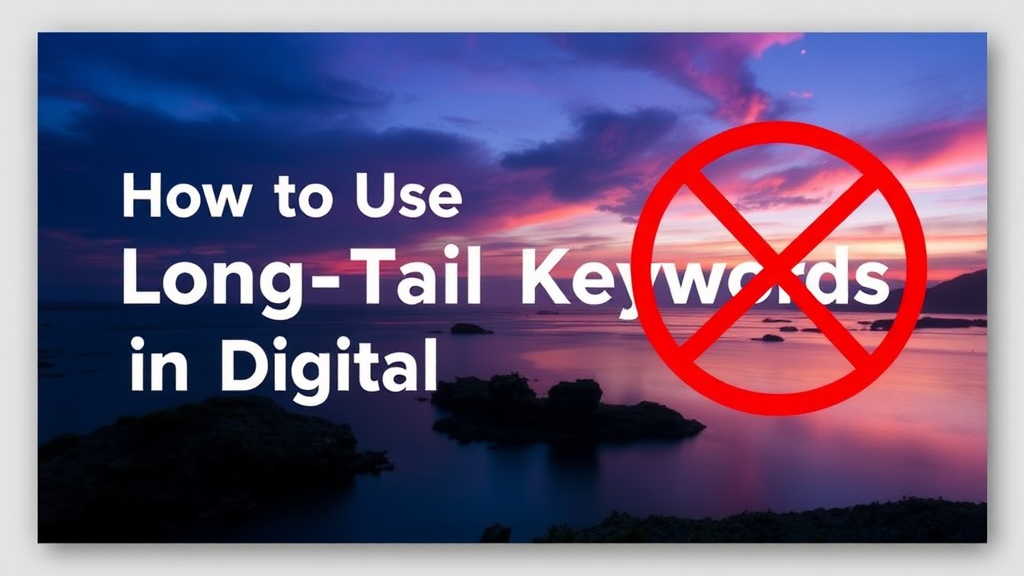Leveraging Long-Tail Keywords for Digital Marketing Success
Unlocking the Power of Long-Tail Keywords
In the dynamic world of digital marketing, staying ahead of the curve is crucial for success. One often overlooked, yet highly effective, strategy is the utilization of long-tail keywords. These specific, niche-focused keywords can be the key to unlocking a wealth of opportunities and driving targeted traffic to your online presence.
Understanding the Significance of Long-Tail Keywords
Long-tail keywords are phrases that are more specific and targeted than broad, generic keywords. They tend to be longer, more descriptive, and often include modifiers such as location, intent, or product features. While they may have lower search volume compared to their broader counterparts, long-tail keywords can be incredibly valuable for several reasons:
- Lower Competition: Since long-tail keywords are more specific, they typically have lower competition, making it easier for your content to rank higher in search engine results.
- Targeted Traffic: Long-tail keywords attract users who are further along in the buying cycle, as they are searching for more specific information or products. This means higher conversion rates and better return on investment (ROI).
- Increased Relevance: By targeting long-tail keywords, you can create content that is highly relevant to your audience’s search intent, providing a better user experience and building trust with your brand.
Long-Tail Keywords into Your Digital Marketing Strategy
Leveraging long-tail keywords requires a strategic and systematic approach. Here are some steps to help you get started:
1. Conduct Thorough Keyword Research
Utilize keyword research tools to identify relevant long-tail keywords that align with your business objectives and target audience. Look for phrases that have a manageable level of competition and significant search volume.
2. Create Targeted Content
Develop content that addresses the specific queries and needs of your target audience. This could include blog posts, product pages, or even video content that focuses on the long-tail keywords you’ve identified.
3. Optimize for Search Engines
Ensure that your content is optimized for search engines by incorporating the long-tail keywords into your page titles, meta descriptions, headers, and body text. This will help improve your visibility in search engine results pages (SERPs).
4. Leverage Long-Tail Keywords Across Platforms
Utilize long-tail keywords not only in your website content but also in your social media posts, email marketing campaigns, and other digital marketing channels. This will help create a consistent and cohesive brand presence.
5. Continuously Monitor and Refine
Regularly analyze your website’s performance and track the effectiveness of your long-tail keyword strategy. Adjust your approach as needed to ensure that you’re continually reaching and engaging your target audience.
Unlocking the Full Potential of Long-Tail Keywords
By embracing the power of long-tail keywords, you can unlock a wealth of opportunities for your digital marketing efforts. From lower competition and targeted traffic to increased relevance and better ROI, the strategic use of long-tail keywords can be a game-changer for your online success. Embrace this powerful approach and watch as your digital marketing efforts soar to new heights.
Optimizing Content for Long-Tail Keyword Visibility
Understand the Power of Long-Tail Keywords
As digital marketing continues to evolve, the importance of long-tail keywords has become increasingly evident. These are the specific, often more niche-focused search queries that users type into search engines, and they can be a powerful tool for driving targeted traffic to your website.
Unlike broad, high-volume keywords, long-tail keywords typically have lower search volume but often represent users with a higher intent to convert. By optimizing your content for these types of keywords, you can increase your chances of appearing in the search results for the exact queries your target audience is searching for.
Identify Relevant Long-Tail Keywords
The first step in optimizing your content for long-tail keyword visibility is to identify the most relevant and valuable long-tail keywords for your business. This can be done through keyword research tools, such as Google Keyword Planner, Ahrefs, or SEMrush, which can help you uncover long-tail keywords related to your products, services, or industry.
When conducting your keyword research, look for keywords that have a good balance of search volume and low competition. These are the sweet spots where you can potentially rank higher and drive more qualified traffic to your website.
Incorporate Long-Tail Keywords into Your Content
Once you have identified your target long-tail keywords, it’s time to start incorporating them into your content. This doesn’t mean simply stuffing your content with keywords – that can actually hurt your search engine rankings. Instead, focus on naturally weaving the keywords into your writing in a way that provides value to your readers.
Optimize Your Page Titles and Meta Descriptions
Start by optimizing your page titles and meta descriptions to include your long-tail keywords. These elements play a crucial role in how your content appears in the search engine results pages (SERPs), so it’s important to make them compelling and informative.
Incorporate Keywords into the Body of Your Content
Next, look for opportunities to incorporate your long-tail keywords into the body of your content. This could involve using the keywords in headlines, subheadings, and throughout the text in a natural, contextual way. Remember, the goal is to create content that is informative and engaging, not just keyword-stuffed.
Use Variations and Semantically Related Keywords
In addition to your primary long-tail keywords, consider using variations and semantically related keywords throughout your content. This can help you capture a wider range of search queries and demonstrate to search engines that your content is relevant and comprehensive.
Optimize for User Intent and Experience
When optimizing your content for long-tail keyword visibility, it’s important to keep the user experience in mind. Remember, the goal is not just to rank for keywords, but to provide value to your audience and address their specific needs and queries.
Understand User Intent
Take the time to understand the intent behind the long-tail keywords you’re targeting. Is the user looking for information, a product, or a solution to a problem? Align your content to meet those needs and expectations.
Enhance the User Experience
Ensure that your content is well-structured, easy to navigate, and visually appealing. Use headings, subheadings, and bullet points to make the information easy to scan and digest. Additionally, consider incorporating multimedia elements, such as images or videos, to make your content more engaging and informative.
Continuously Monitor and Optimize
Optimizing your content for long-tail keyword visibility is an ongoing process. Regularly monitor your search engine rankings, track your website’s performance, and make adjustments to your content and strategy as needed.
Stay up-to-date with the latest SEO trends and best practices, and be willing to experiment and try new approaches. By continuously refining and optimizing your content, you can maximize your visibility in the search results and drive more targeted, high-intent traffic to your website.
Conclusion
Leveraging Long-Tail Keywords for Digital Marketing Success
Long-tail keywords can be a powerful tool for digital marketers looking to drive targeted traffic and increase conversions. By focusing on more specific, niche-oriented search phrases, businesses can position themselves as experts in their field and better connect with the right audience.
The key is to carefully research and identify the long-tail keywords that are most relevant to your products, services, and target customers. This involves analyzing search volume, competition levels, and intent to ensure you’re targeting terms that people are actively searching for. Tools like Google Keyword Planner, SEMrush, and Ahrefs can be invaluable in this process.
Once you’ve built out a list of promising long-tail keywords, the next step is to optimize your content accordingly. This means naturally incorporating the terms throughout your website, blog posts, product descriptions, and other digital assets. Focus on providing genuine value and addressing the specific pain points and questions of your target audience, rather than simply stuffing keywords.
High-quality, long-form content that is tailored to long-tail queries tends to perform best. Search engines favor in-depth, informative pieces that comprehensively cover a topic. Additionally, ensuring your content is well-structured, visually appealing, and easy to navigate can further boost its visibility and engagement.
Optimizing for Long-Tail Keyword Visibility
Beyond content creation, there are several other strategies digital marketers can leverage to maximize the visibility of their long-tail keyword-focused efforts. Technical SEO best practices, such as optimizing page titles, meta descriptions, and image alt text, can enhance a page’s relevance and rankings for specific search queries.
Building a robust internal linking structure that connects related content can also help search engines better understand the context and hierarchy of your website, making it easier for your long-tail pages to rank. Additionally, securing high-quality backlinks from authoritative, relevant sources can significantly boost the credibility and authority of your long-tail content.
Ultimately, the key to long-tail keyword success in digital marketing lies in a comprehensive, user-centric approach. By deeply understanding your audience, creating valuable content that addresses their specific needs, and strategically optimizing your online presence, you can unlock a treasure trove of targeted traffic and increased conversions. As search behaviors continue to evolve, mastering the art of long-tail keyword targeting will only become more crucial for businesses looking to stay ahead of the competition.



